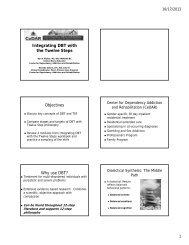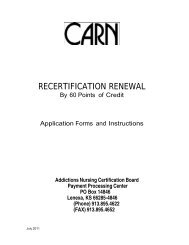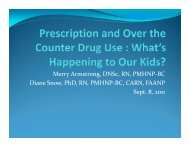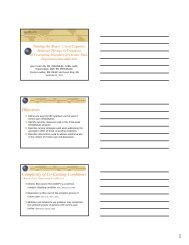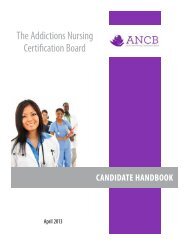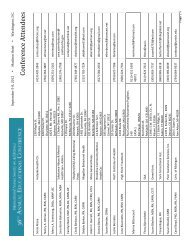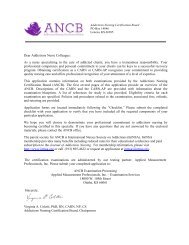Vision Mission Values - International Nurses Society on Addictions
Vision Mission Values - International Nurses Society on Addictions
Vision Mission Values - International Nurses Society on Addictions
Create successful ePaper yourself
Turn your PDF publications into a flip-book with our unique Google optimized e-Paper software.
2010/2011<str<strong>on</strong>g>Missi<strong>on</strong></str<strong>on</strong>g>To advance excellence in nursing care for the preventi<strong>on</strong> and treatment ofaddicti<strong>on</strong>s for diverse populati<strong>on</strong>s across all practice settings throughadvocacy, collaborati<strong>on</strong>, educati<strong>on</strong>, research and policy development.<str<strong>on</strong>g>Visi<strong>on</strong></str<strong>on</strong>g>Our goal is to help nurses provide comprehensive, high-quality nursing care for addictedpatients and their families. IntNSA has something to offer every nurse, regardless of theirarea of nursing practice. With the prevalence of addicti<strong>on</strong>-related health c<strong>on</strong>sequences,we believe that all nurses must maintain a basic level of knowledge and skills in addicti<strong>on</strong>s.To be a global leader in addicti<strong>on</strong>s nursing.Our strength comes from our members, including clinicians, educators, managers andresearchers who practice in a wide variety of settings, including treatment centers, hospitals,schools, private practices, primary care and other community agencies. We firmlybelieve that all nurses, regardless of their specialty or practice setting, can play a role inthe promoti<strong>on</strong> of healthy lifestyles and the early identificati<strong>on</strong> of people at greater riskfor developing problems associated with the abuse of addictive substances<str<strong>on</strong>g>Values</str<strong>on</strong>g>Excellence: Reinvigorating efforts to improve quality of care and quality of life for all pers<strong>on</strong>simpacted by substance use, abuse and addicti<strong>on</strong>.Compassi<strong>on</strong>: Recognizing the importance of helping others through caring. Instillinghope to those who feel hopeless and empowering those who are powerless.Diversity: Affirming and accepting the uniqueness of each pers<strong>on</strong> – his/her idea, values,culture and ethnicity.Integrity: Respecting the dignity and worth of every individual grounded <strong>on</strong> the understandingthat addicti<strong>on</strong>s, like other chr<strong>on</strong>ic health problems can be prevented and treated.
IntNSA Annual ReportPage 22010-2011 Board of DirectorsPresidentDeborah S. Finnell, DNS, PMHNP-BC, CARN-APNew Yorkfinnell@buffalo.edu | Term expires: 2012President ElectAlbert Rundio Jr., PhD, DNP, APRN-BC, CARN-APNew Jerseyarundio@aol.com | Term expires: 2012SecretaryDana Murphy-Parker, MS, RN, APRN-BCWyomingdmurphyp@uwyo.edu | Term expires: 2011TreasurerElizabeth Pace, MSM, RN, CEAPDenverepace@peerassist.org | Term expires: 2011DirectorsSuzan Blacher, MSN, CARN, RNFloridasuzanb5753@aol.com | Term expires: 2011Colleen Corte, PhD, RNIllinoisccorte@uic.edu | Term expires: 2011Tara Haskins, RN, MSN, FPMHNP-BCLouisianataratingle@gmail.com | Term expires: 2011Judith Tomlins<strong>on</strong>, RN, CARNVirginiajtomlins<strong>on</strong>@mcvh-vcu.edu | Term expires: 2012Debra F. Hobbins, DNP, APRN, LSAC, CARN-APUtahdebra.hobbins@gmail.com | Term expires: 2012Stephen Strobbe, PhD, RN, NP, PMHCNS-BC, CARNMichiganstrobbe@med.umich.edu | Term expires: 2012Becky Eisenhut, MS, RN, CASAC, CARNNew Yorkbecky.eisenhut@nysna.org | Term expires: 2012Ex OfficioFoundati<strong>on</strong> for Addicti<strong>on</strong>s Nursing PresidentDiane Snow, PhD, APRN, BC, PMHNPTexassnow@uta.eduAddicti<strong>on</strong>s Nursing Certificati<strong>on</strong> Board PresidentVirginia Colletti, PhD, RN, NPP, CARN, CSNew YorkVirginia_Coletti@notes2.nursing.sunysb.eduJournal of Additi<strong>on</strong>s Nursing EditorChristine Vourakis, DNSc, RNCaliforniacvourakis@csus.eduExecutive Office StaffExecutive DirectorM<strong>on</strong>ica Evans-Lombemevanslombe@goamp.comGovernmental Affairs DirectorWade Delkwdelk@goamp.comEducati<strong>on</strong>al Programming CoordinatorChristie Rosscross@goamp.comAdministrative AssistantPatricia Paynepatricia.payne@goamp.comMeeting ManagerT<strong>on</strong>ja Brittt<strong>on</strong>ja.britt@goamp.comData AdministratorSusan Himeshime@goamp.comAccounting CoordinatorKathy Ramseierkramseier@goamp.comIntNSA Executive OfficeP.O. Box 14846 * Lenexa, KS 66285-4846Ph<strong>on</strong>e: 913.895.4622 * Fax: 913.895.4652E-mail: intnsa@intnsa.orgWebsite: www.intnsa.org
2010/2011Page 3Letter from the IntNSA President and Executive DirectorTo IntNSA Members and Friends of IntNSA,The past year has been <strong>on</strong>e of exciting change and increased visibility for our organizati<strong>on</strong>. Our focus remains<strong>on</strong> our missi<strong>on</strong> to advance excellence in nursing care for the preventi<strong>on</strong> and treatment of addicti<strong>on</strong>sfor diverse populati<strong>on</strong>s across all practice settings through advocacy, collaborati<strong>on</strong>, educati<strong>on</strong>, researchand policy development.IntNSA’s strategic focus areas provide the framework for this year’s annual report. You will find examplesof some of the important work that IntNSA has d<strong>on</strong>e <strong>on</strong> your behalf. Some of our accomplishments havebeen very visible and tangible, such as our new website http://www.intnsa.org and the positi<strong>on</strong> paper releasedin June, “The Prescribing of Buprenorphine by Advanced Practice Addicti<strong>on</strong>s <str<strong>on</strong>g>Nurses</str<strong>on</strong>g>.” Our advocacyand policy development has been increasingly evident in reports from Wade Delk, Governmental AffairsDirector. Our advocacy for you and for the populati<strong>on</strong>s we serve has clearly increased IntNSA’s visibility <strong>on</strong>Capitol Hill and bey<strong>on</strong>d.Our focus <strong>on</strong> developing partnerships and collaborati<strong>on</strong>s has led to this year’s c<strong>on</strong>ference with the American<str<strong>on</strong>g>Society</str<strong>on</strong>g> for Pain Management Nursing. Another significant accomplishment has been IntNSA’s receiptof a research subaward <strong>on</strong> the American Academy of Addicti<strong>on</strong> Psychiatry (AAAP) grant. This award addsto our portfolio of successful grant funding, al<strong>on</strong>g with the grant IntNSA was awarded from the SubstanceAbuse & Mental Health Services Administrati<strong>on</strong>/Center for Substance Abuse Treatment for the 2009IntNSA c<strong>on</strong>ference.Less visible, but critically important, are our initiatives related to the leadership of the organizati<strong>on</strong>. Wehave engaged in board development through a structured educati<strong>on</strong>al program, implementati<strong>on</strong> ofknowledge-based governance philosophy and tools for decisi<strong>on</strong> making, and expanded leadership rolesand resp<strong>on</strong>sibilities for board members.We want to emphasize our commitment to you, our members. Without your support n<strong>on</strong>e of this importantwork could be accomplished. As you read through this report, please c<strong>on</strong>sider ways that you canc<strong>on</strong>tribute to your organizati<strong>on</strong>. Your participati<strong>on</strong> helps promote the specialty of addicti<strong>on</strong>s nursing, yourpatients, your community and your professi<strong>on</strong>al development.Thank you for being a member of IntNSA and for your commitment to promoting the health and wellbeingof pers<strong>on</strong>s impacted by substance use, misuse and addicti<strong>on</strong>s.Deborah S. Finnell, DNS, PMHNP-BC, CARN-APIntNSA PresidentM<strong>on</strong>ica A. Evans-LombeExecutive Director
IntNSA Annual ReportPage 4Focus Area #1: Governance and LeadershipWe will foster active participati<strong>on</strong> in the governance and leadership of IntNSA to ensure effective management andaccountability at all levels. We will proactively implement a leadership successi<strong>on</strong> plan for all levels of leadership inthe organizati<strong>on</strong>.2010 Activities Board Development – The Board participated in m<strong>on</strong>thly educati<strong>on</strong> related to building an effective associati<strong>on</strong> Board. Thisactivity has dem<strong>on</strong>strated a pers<strong>on</strong>al and organizati<strong>on</strong>al desire to develop the knowledge, fortitude, expertise and commitmentto support effective governance structures, processes and culture within the organizati<strong>on</strong>. Knowledge Based Governance – The Board has adopted the Knowledge Based Governance (KBG) approach to decisi<strong>on</strong>making. This governance style encourages open dialogue and increases the quality and speed with which the Board makesdecisi<strong>on</strong>s. KBG is based <strong>on</strong> three comp<strong>on</strong>ents: knowledge, trust and nimbleness. Strategic Planning – The Board participated in a two-day Strategic Planning meeting in April 2011 at the IntNSA ExecutiveOffice in Olathe, KS. While issues of immediate c<strong>on</strong>cern were addressed, the majority of time was devoted to strategicplanning. C<strong>on</strong>tracts –The Board is committed to establishing stability and c<strong>on</strong>tinuity for the organizati<strong>on</strong>. To accomplish this, l<strong>on</strong>gtermc<strong>on</strong>tracts have been established with trusted partners for:□ Management Services□ Testing Administrati<strong>on</strong>□ PublishingFuture ActivitiesWorkgroup/Taskforce Leadership – The Board will be working to establish a formal volunteer structure to move projectsforward, create more ways for members to get involved and develop future leaders.New Orientati<strong>on</strong> Process – The Executive Committee is committed to providing a formal orientati<strong>on</strong> process to help establishexpectati<strong>on</strong>s and ensure the success for all directors as they are newly elected.Focus Area #2: Organizati<strong>on</strong>al IdentityWe will use the outcomes of our strategic planning to define our role in nursing as the leader in preventi<strong>on</strong>,interventi<strong>on</strong>, treatment, and management of pers<strong>on</strong>s with substance use, abuse and addicti<strong>on</strong>s. Based <strong>on</strong> thisrole, IntNSA will be recognized by instituti<strong>on</strong>al leadership for the value of employee memberships. IntNSA will alsobe valued for our expertise by the nursing and the broader community as well as the media.IntNSA is increasingly being recognized by leaders in the nursing community, addicti<strong>on</strong>sfield and media. This evidence is provided in Focus Area # 6.A significant accomplishment was the launch of the new website in June 2011. Thebranding and format used <strong>on</strong> the website will be carried across other materials, productsand publicati<strong>on</strong>s to provide a standard appearance, recogniti<strong>on</strong> and associati<strong>on</strong>with IntNSA.Future ActivitiesIn carrying out our missi<strong>on</strong>, through our publicati<strong>on</strong>s including the Journal of Addicti<strong>on</strong>sNursing, and disseminating our beliefs and recommendati<strong>on</strong>s, we will enhanceour recogniti<strong>on</strong> as global leaders in addicti<strong>on</strong>s nursing. Input and suggesti<strong>on</strong>s are welcome.
The IntNSA membership is comprised of a diverse group of professi<strong>on</strong>als practicing in many areas including:2010/2011Focus Area #3: Recruitment and Retenti<strong>on</strong> of MembersIntNSA will have in place a comprehensive marketing plan for recruitment and retenti<strong>on</strong> of members whichfocuses <strong>on</strong> representing all c<strong>on</strong>ceivable groups of nursing professi<strong>on</strong>als who care for individuals, groups andpopulati<strong>on</strong>s impacted by substance use, abuse, and addicti<strong>on</strong>s. Outcomes are represented by specificbenchmarks for new members, current members, and special groups. Additi<strong>on</strong>ally, IntNSA will have in placeformal policies for clear and understandable fee structures and relati<strong>on</strong>ships with chapters and affiliates. General Hospital Detoxificati<strong>on</strong> unit Addicti<strong>on</strong>s specialty hospital/unit Substituti<strong>on</strong> clinic Educati<strong>on</strong>al instituti<strong>on</strong> Community agency Private practice State/federal agencyFree-standing unitPage 5IntNSA’s membership has been stable over recent years. While we have experienced times with slight decreases in membership,the organizati<strong>on</strong> has a solid foundati<strong>on</strong> from which to grow. IntNSA is poised to do so by using targeted messaging andoutreach.IntNSA currently has nine chapters across the United States. Members are encouraged to start chapters to bring nurses specializingin addicti<strong>on</strong>s together to carry out the organizati<strong>on</strong>’s missi<strong>on</strong> at a local / regi<strong>on</strong>al level. Chapters can serve to educatemembers as well as the public. Chapters also promote networking and support. IntNSA’s visibility and membership growthare promoted by our Chapters. The Massachusetts Chapter of the <str<strong>on</strong>g>Internati<strong>on</strong>al</str<strong>on</strong>g> <str<strong>on</strong>g>Nurses</str<strong>on</strong>g> <str<strong>on</strong>g>Society</str<strong>on</strong>g> <strong>on</strong> Addicti<strong>on</strong>s, our newest chapter, was officially instatedin July 2011. The Chapter handbook was revised to help make the process for starting a chapter even easier. Incentives for membership have been added with the new rates for certificati<strong>on</strong>. (See Focus Area # 5).Future ActivitiesIntNSA will utilize the KBG approach in brainstorming ideas for growing our membership.Efforts are underway to encourage the development of Chapters outside the United States.IntNSA will increase marketing efforts for the Certified Addicti<strong>on</strong>s Registered Nurse (CARN) and CARN-Advanced Practice,given the recognized value of and demand for this specialty nursing certificati<strong>on</strong> within and outside the United States.
IntNSA Annual ReportPage 6Focus Area #4: Policy and AdvocacyWe will effectively present ways the nati<strong>on</strong> can improve patient care, while reducing the frustrati<strong>on</strong>s andchallenges our members face in daily practice. Addicti<strong>on</strong>s nurses influence legislati<strong>on</strong> and positively impact theirpractice. We will provide ways for members to participate in IntNSA’s grass roots efforts.Governmental Affairs Director – Wade Delk serves as Governmental Affairs Director for IntNSA. In this role Wade assistsIntNSA leadership in developing a legislative strategy and with legislative initiatives. He increases our visibility with relatedorganizati<strong>on</strong>s by actively participating in coaliti<strong>on</strong>s and advocating our positi<strong>on</strong> to legislators and the regulators.Additi<strong>on</strong>ally he helps identify the stakeholders that need to be engaged, develops communicati<strong>on</strong>s strategies to informmembers and other stakeholders of the associati<strong>on</strong>s’ positi<strong>on</strong>, m<strong>on</strong>itors legislati<strong>on</strong> and notifies IntNSA leadershipwhen obstacles are encountered al<strong>on</strong>g with a recommended plan of acti<strong>on</strong>.Buprenorphine Positi<strong>on</strong> Paper – IntNSA has been a leader in promoting increased access to buprenorphine treatment withopioid dependence and through publicati<strong>on</strong>s calling for amendment of the Drug Addicti<strong>on</strong> Treatment Act of 2000. In resp<strong>on</strong>seto increased urgency for IntNSA to articulate a formal positi<strong>on</strong>, this positi<strong>on</strong> paper was released in June 2011, posted<strong>on</strong> the IntNSA website, and broadly disseminated.REMS - The Risk Evaluati<strong>on</strong> Mitigati<strong>on</strong> Strategy (REMS) Taskforce is a multiorganizati<strong>on</strong>al taskforce which was formed todevelop a White Paper report regarding REMS for opioid therapy. The group is comprised of members from multiple organizati<strong>on</strong>s(IntNSA, American <str<strong>on</strong>g>Society</str<strong>on</strong>g> for Pain Management Nursing, American Associati<strong>on</strong> of Nurse Anesthetists, AmericanAcademy of Nurse Practiti<strong>on</strong>ers, American Academy of Physician Assistants, Hospice and Palliative <str<strong>on</strong>g>Nurses</str<strong>on</strong>g> Associati<strong>on</strong> andthe Oncology Nursing <str<strong>on</strong>g>Society</str<strong>on</strong>g>). The members met and collaborated through face-to-face meetings and c<strong>on</strong>ference calls todevelop the paper <strong>on</strong> REMS. The presenters summarized the findings and positi<strong>on</strong> of the taskforce at the 2011 c<strong>on</strong>ference.Future ActivitiesIntNSA now has an exemplar Positi<strong>on</strong> Paper that serves as a template for future <strong>on</strong>es. We encourage ideas from membersfor future positi<strong>on</strong> papers as vehicles to make public our official beliefs and recommendati<strong>on</strong>s.Focus Area #5: Educati<strong>on</strong>, Professi<strong>on</strong>al Development and Certificati<strong>on</strong>We will provide quality educati<strong>on</strong>al and professi<strong>on</strong>al development offerings to meet the changing needs ofaddicti<strong>on</strong>s and other specialty nursing professi<strong>on</strong>als. IntNSA c<strong>on</strong>ferences and events will be recognized as theeducati<strong>on</strong>al venues of the year attracting highly-qualified experts in the professi<strong>on</strong>.Through the Addicti<strong>on</strong>s Nursing Certificati<strong>on</strong> Board (ANCB) we will promote the highest standards of addicti<strong>on</strong>snursing practice through development, implementati<strong>on</strong> and coordinati<strong>on</strong> of all aspects of certificati<strong>on</strong> foraddicti<strong>on</strong>s nurses.The IntNSA membership is comprised of a diverse group of professi<strong>on</strong>als who are in different stages of their nursing careers.IntNSA c<strong>on</strong>tinued to offer its members new educati<strong>on</strong>al opportunities in 2010-2011. Members network with peers to developmeaningful relati<strong>on</strong>ships and advance careers. Members inspire and energize each other to make a difference. As c<strong>on</strong>veyed inour missi<strong>on</strong>, our members represent nurses working with diverse populati<strong>on</strong>s across all practice settings.
2010/2011Page 7While c<strong>on</strong>ference attendance has slightly decreased recently, the organizati<strong>on</strong> has fared well in the recessi<strong>on</strong>. In a recent surveyto the membership, questi<strong>on</strong>s regarding c<strong>on</strong>tinuing educati<strong>on</strong> yielded the following results:78% indicated their department or agency had been affected by budget c<strong>on</strong>straints, and 64% say that affected their educati<strong>on</strong>alsupport budget line.63% indicated cost/budget c<strong>on</strong>straints were the number-<strong>on</strong>e reas<strong>on</strong> they were not able to attend the IntNSA c<strong>on</strong>ference.56% indicated they currently pay for their registrati<strong>on</strong> and expenses for c<strong>on</strong>tinuing educati<strong>on</strong> needs.Educati<strong>on</strong>al Offerings 2010 Annual Educati<strong>on</strong>al C<strong>on</strong>ference – Over 150 nurses gathered at the 2010 C<strong>on</strong>ference which was held in Greenwich,CT <strong>on</strong> October 20-23, 2010. The theme, "Learning from Each Other—A Global Perspective of Addicti<strong>on</strong>s," was evident inboth attendees and speakers. The c<strong>on</strong>ference provided opportunities to interact with colleagues from the U.S. and variouscountries. Dialogue, networking, and formal presentati<strong>on</strong>s served to broaden c<strong>on</strong>ference attendees’ perspectives <strong>on</strong> addicti<strong>on</strong>snursing. 2011 Annual Educati<strong>on</strong>al C<strong>on</strong>ference – The 2011 C<strong>on</strong>ference was held jointly with the American <str<strong>on</strong>g>Society</str<strong>on</strong>g> for Pain ManagementNursing. This joint meeting facilitated over 600 nurses coming together for a comm<strong>on</strong> goal. The two nursing specialtyorganizati<strong>on</strong>s joined in the challenge of working with individuals experiencing pain at risk for addicti<strong>on</strong> and individualswith addicti<strong>on</strong>s who are experiencing pain. IntNSA and ASPMN® combined their expertise seeking to improve the qualityof life for this populati<strong>on</strong>. CE Feature Articles in Journal of Addicti<strong>on</strong>s Nursing - IntNSA Offers C<strong>on</strong>tinuing Educati<strong>on</strong> credits in each issue of the Journalof Addicti<strong>on</strong>s Nursing by way of a CE Feature Article, which allows the reader to answer a series of post-test questi<strong>on</strong>sand submit it for CE credit. Online Educati<strong>on</strong> Offerings – IntNSA will be offering a webinar series offering Training, Educati<strong>on</strong> and Peer Support forOpioid Prescribers in all Health Professi<strong>on</strong>s. IntNSA was awarded a three-year subc<strong>on</strong>tract <strong>on</strong> the American Academy of Addicti<strong>on</strong> Psychiatry (AAAP) grant, “The Prescribers’Clinical Support System for Opioids.” This grant from the Center for Substance Abuse Treatment/SubstanceAbuse and Mental Health Services Administrati<strong>on</strong> is effective July 1, 2011. The grant funds a program that will utilize innovativeapproaches to educating all clinicians who prescribe opioids. The program has two main focuses; <strong>on</strong>e is <strong>on</strong> the useof opioid therapies for treatment of opioid dependence, and the sec<strong>on</strong>d focuses <strong>on</strong> the safe use of opioids in treatment ofchr<strong>on</strong>ic pain, including training <strong>on</strong> how to recognize misuse, abuse and addicti<strong>on</strong> in those with pain.The project includes a large number of partners who will c<strong>on</strong>tribute to the development of educati<strong>on</strong>al materials includingwebinar trainings, trainings at nati<strong>on</strong>al meetings and clinical tools to assist practicing clinicians including physicians, dentistsand nurse practiti<strong>on</strong>ers.Certificati<strong>on</strong> Program The Board is committed to establishing stability and c<strong>on</strong>tinuity for the organizati<strong>on</strong>. To accomplish this, a l<strong>on</strong>g term c<strong>on</strong>tracthas been established for testing and recertificati<strong>on</strong> processing. In order to generate revenue without losing sight of IntNSA’s important missi<strong>on</strong>, the Board adjusted certificati<strong>on</strong> fees withincentive for joining IntNSA. IntNSA has taken a proactive approach to the l<strong>on</strong>gevity and viability of the certificati<strong>on</strong> program. They are investing cashreserves in funding a Role Delineati<strong>on</strong> Study and Exam Development for both the CARN and CARN-AP. The Addicti<strong>on</strong>s Nursing Certificati<strong>on</strong> Board maintains member status with the American Board of Nursing Specialties(ABNS). As ANCB c<strong>on</strong>tinues efforts to realize accreditati<strong>on</strong> for the certificati<strong>on</strong> examinati<strong>on</strong>s, membership in ABNS providesguidance and directi<strong>on</strong>, as well as <strong>on</strong>going support in the applicati<strong>on</strong> process. There are currently 698 certified addicti<strong>on</strong>s nurses, 637 CARN and 61 CARN-AP. ANCB tested 92 candidates in 2010-2011.
IntNSA Annual ReportPage 8Focus Area #5: Educati<strong>on</strong>, Professi<strong>on</strong>al Development and Certificati<strong>on</strong>...c<strong>on</strong>tinuedThere is increasing awareness of and demand for certificati<strong>on</strong> in addicti<strong>on</strong>s nursing. Examples of driving forces include hospitalsseeking Magnet Status; the new opti<strong>on</strong>al Screening, Brief Interventi<strong>on</strong>, and Referral to Treatment (SBIRT)-relatedmeasure sets from The Joint Commissi<strong>on</strong>; and IntNSA’s Buprenophine Positi<strong>on</strong> Paper, are just a few. Addicti<strong>on</strong>s nursingcertificati<strong>on</strong> through the Addicti<strong>on</strong>s Nursing Certificati<strong>on</strong> Board is specifically menti<strong>on</strong>ed in a 2011 document, WorkforcesIssues Related to Physical and Behavioral Healthcare Integrati<strong>on</strong> developed for the joint Office of Nati<strong>on</strong>al Drug C<strong>on</strong>trol Policy/SubstanceAbuse Mental Health Services Administrati<strong>on</strong>/Health Services and Services Administrati<strong>on</strong> Joint Commissi<strong>on</strong>performance.Future Activities2012 Annual Educati<strong>on</strong>al C<strong>on</strong>ference – The 2012 C<strong>on</strong>ference will be held September 5-8, 2012 in Washingt<strong>on</strong>, DC. Thetheme for 2012 is: <str<strong>on</strong>g>Nurses</str<strong>on</strong>g> Caring for Patients across the C<strong>on</strong>tinuum of Substance Use: Leading Change and Advancing HealthThis c<strong>on</strong>ference focuses <strong>on</strong> the requisite knowledge, skills and abilities for any nurse who cares for pers<strong>on</strong>s with substanceuse, abuse and addicti<strong>on</strong>s. This c<strong>on</strong>ference has a special focus <strong>on</strong> the evidence-based approach to universally screen andidentify substance use am<strong>on</strong>g pers<strong>on</strong>s in diverse health care settings. Screening, Brief Interventi<strong>on</strong> and Referral to Treatment(SBIRT) – is ranked am<strong>on</strong>g the highest preventi<strong>on</strong> priority worldwide and has dem<strong>on</strong>strated effectiveness in reducingrisky substance use and related c<strong>on</strong>sequences including injuries, illnesses and hospital re-admissi<strong>on</strong>s. In 2012, these clinicalstrategies will be opti<strong>on</strong>al mandates for hospitals accredited by or seeking accreditati<strong>on</strong> from The Joint Commissi<strong>on</strong>.The Institute of Medicine has called for nurses to practice at the ‘top of their license.’ <str<strong>on</strong>g>Nurses</str<strong>on</strong>g>, across all practice settings inroles of preventi<strong>on</strong> and treatment have the opportunity to lead change and advance health for diverse populati<strong>on</strong>s. Assuch, any nurse needs the requisite skills to identify individuals at risk for substance use, abuse and addicti<strong>on</strong>s. With challengescome opportunities. This c<strong>on</strong>ference seeks to attract nurses from various specialties and individuals from other disciplines,encouraging transdisciplinary dialogue focusing <strong>on</strong> advancing health of the populati<strong>on</strong>s we serve.Focus Area #6: Visibility, Collaborati<strong>on</strong>s and PartnershipsPotential sp<strong>on</strong>sors and partners will recognize the value of investing in IntNSA, and related professi<strong>on</strong>alassociati<strong>on</strong>s will value and pursue collaborative relati<strong>on</strong>ships.In keeping with our visi<strong>on</strong> to be a global leader in addicti<strong>on</strong>s nursing, IntNSA engages in synergistic relati<strong>on</strong>ships with othernursing and professi<strong>on</strong>al organizati<strong>on</strong>s/groups to promote our missi<strong>on</strong>. The following accomplishments dem<strong>on</strong>strate ourexpansi<strong>on</strong> in this focus area. American <str<strong>on</strong>g>Society</str<strong>on</strong>g> of Pain Management Nursing (ASPMN®) – IntNSA partnered with ASPMN® and others in a taskforce anddevelopment of White Paper related to the Risk Evaluati<strong>on</strong> Mitigati<strong>on</strong> Strategy (REMS) see Focus Area # 4) and the 2011Educati<strong>on</strong>al C<strong>on</strong>ference, Management of Pain & Addicti<strong>on</strong>s: Broadening Our Perspectives. IntNSA was approached by the American Associati<strong>on</strong> for Addicti<strong>on</strong> Psychiatry (AAAP) to collaborate <strong>on</strong> a grant related toopioid therapies. IntNSA received a subaward (AAAP005) <strong>on</strong> that 3-year AAAP-funded project, Prescribers Clinical SupportSystem for Opioid Therapies (1H79Ti023439-01) from SAMHSA. IntNSA was a catalyst for a Global Addicti<strong>on</strong>s Nursing Summit held in L<strong>on</strong>d<strong>on</strong>, United Kingdom <strong>on</strong> June 1 and 2, 2011. Adetailed report <strong>on</strong> the accomplishments was provided in the August 8, 2011 issue of the IntNSA NewsWave, 2(4). Therewere about 40 attendees who represented nursing and social work. The discussi<strong>on</strong> was lively, focused <strong>on</strong> promotingaddicti<strong>on</strong>s nursing and was framed within the c<strong>on</strong>text that there are more than 17 milli<strong>on</strong> nurses and midwives in the world(World Health Organizati<strong>on</strong>, 2010). The Global Addicti<strong>on</strong>s Nursing Network launched <strong>on</strong> Facebook immediately after theSummit dem<strong>on</strong>strates the power of bringing together nurses specializing in addicti<strong>on</strong>s.
2010/2011Page 9The Director of the Nati<strong>on</strong>al Institute <strong>on</strong> Drug Abuse Clinical Trials Network (NIDA CTN) reached out to IntNSA to discusspotential collaborati<strong>on</strong>s and partnerships. As a result, NIDA CTN has engaged with the IntNSA 2012 Educati<strong>on</strong>al C<strong>on</strong>ferenceplanning committee with the goal of having an active role in that c<strong>on</strong>ference.IntNSA was asked by Eric Goplerud, PhD to participate in a think tank focusing <strong>on</strong> efforts to disseminate drug and alcoholScreening, Brief Interventi<strong>on</strong>, and Referral to Treatment (SBIRT) in hospitals. The initial meeting, held <strong>on</strong> August 23, 2011in Washingt<strong>on</strong>, DC was cut short by the earthquake that afterno<strong>on</strong>. The think-tank group is developing a multi-pr<strong>on</strong>g approachto support selecti<strong>on</strong> and implementati<strong>on</strong> of The Joint Commissi<strong>on</strong> measures, wherein IntNSA will have a prominentrole.IntNSA has been asked to write a column/provide an interview for Join Together. The Editor has reached out to IntNSA toc<strong>on</strong>tribute a column with interview in an effort to reach out to nurses in the addicti<strong>on</strong> field.Recovery M<strong>on</strong>th – IntNSA is involved as a Planning Partner in Nati<strong>on</strong>al Recovery M<strong>on</strong>th (Recovery M<strong>on</strong>th) activities, celebratedeach September, in c<strong>on</strong>juncti<strong>on</strong> with the U.S. Department of Health and Human Services' Substance Abuse andMental Health Services Administrati<strong>on</strong>'s Center for Substance Abuse Treatment. In additi<strong>on</strong> to Recovery M<strong>on</strong>th, IntNSAcelebrates Nati<strong>on</strong>al Addicti<strong>on</strong>s <str<strong>on</strong>g>Nurses</str<strong>on</strong>g> Week the last week in September.Organizati<strong>on</strong>al Memberships add value to IntNSA.IntNSA maintains affiliate membership with the American <str<strong>on</strong>g>Nurses</str<strong>on</strong>g> Associati<strong>on</strong> . IntNSA will be represented at the NursingOrganizati<strong>on</strong> Alliance meeting in November 2011. With other affiliates, IntNSA engages in a forum for identificati<strong>on</strong>, educati<strong>on</strong>and collaborati<strong>on</strong> building <strong>on</strong> issues of comm<strong>on</strong> interest to advance the nursing professi<strong>on</strong>. To further IntNSA’svisibility and engagement in ANA, Deborah S. Finnell was nominated for the C<strong>on</strong>gress <strong>on</strong> Nursing Practice, Committee forNursing Practice Standards and Guidelines.The Addicti<strong>on</strong>s Nursing Certificati<strong>on</strong> Board maintains member status with the American Board of Nursing Specialties(ABNS). As ANCB c<strong>on</strong>tinues efforts to realize accreditati<strong>on</strong> for the certificati<strong>on</strong> examinati<strong>on</strong>s, membership in ABNS providesguidance and directi<strong>on</strong>, as well as <strong>on</strong>going support in the applicati<strong>on</strong> process.Future ActivitiesC<strong>on</strong>tinue to be nimble in resp<strong>on</strong>ding to opportunities for collaborati<strong>on</strong>s and partnerships that will advance IntNSA’s missi<strong>on</strong>,and in turn increase our visibility. Please direct inquiries to M<strong>on</strong>ica Evans-Lombe, IntNSA Executive Director.Focus Area #7: Fiscal ManagementWe will implement a financial strategy which plans for timely budgets, a viable investment policy and sufficientreserves. This strategy will ensure that all operating expenses are met and that excess revenues are returned tomembers in the form of goods and services.Revenue GeneratingThe positi<strong>on</strong> of IntNSA is to ensure that budgeted expenses do not exceed revenues, or a zero-balanced budget.However, IntNSA ended the year with expenses totaling $24,038.05 more than revenue, a higher loss than expected.Several large funding sources were not realized, and the high expense of the 2010 c<strong>on</strong>ference c<strong>on</strong>tributed to the year-endloss.The 2011 budget will be even more challenging than the 2010 budget due to the current ec<strong>on</strong>omic market. The Board ofDirectors has looked at several areas that would potentially increase revenue and decrease expenses. Two areas that werec<strong>on</strong>sidered were increasing annual membership dues and increasing annual meeting registrati<strong>on</strong> fees. However, the Boardutilized the KBG process to determine that it would be a greater benefit to the IntNSA membership to keep both theannual dues and annual meeting registrati<strong>on</strong> fees at the same level as 2010. The Board will c<strong>on</strong>tinue to look foropportunities to generate revenue and decrease expenses without losing sight of IntNSA’s important missi<strong>on</strong>.
IntNSA Annual ReportPage 10Future ActivitiesFocus Area #7: Fiscal Management...c<strong>on</strong>tinuedIntNSA Directors will c<strong>on</strong>tinue to be vigilant in overseeing the budget.We will c<strong>on</strong>tinue to explore ways to enhance the finances of the organizati<strong>on</strong>, recognizing the state of the current ec<strong>on</strong>omy.A Prospectus will be completed by the first quarter of 2012. The IntNSA Prospectus will be used for marketing in general,soliciting d<strong>on</strong>ati<strong>on</strong>s and other fund-raising initiatives.Income: Actual vs. BudgetExpenses: Actual vs. BudgetFocus Area #8: ResearchWe will be leaders in the development of evidenced based nursing related to substance use, abuse and addicti<strong>on</strong>(SUAA) with a focus <strong>on</strong> 1) Understanding the factors that c<strong>on</strong>tribute to SUAA, 2) the health and socialc<strong>on</strong>sequences of SUAA, 3) the development of evidenced based nursing practice across all settings for SUAArelatedhealth promoti<strong>on</strong> and preventi<strong>on</strong> that addresses the full c<strong>on</strong>tinuum of risk across the lifespan and 4) thebuilding of research teams with the needed expertise to further the development of nursing SUAA science.IntNSA’s nati<strong>on</strong>al and internati<strong>on</strong>al presence offers addicti<strong>on</strong>s nurses access to like-minded scientists and industry informati<strong>on</strong>.Through IntNSA, addicti<strong>on</strong>s nursing professi<strong>on</strong>als from around the world have the opportunity to share research and ideas.IntNSA members are proud to bel<strong>on</strong>g to a support system that they trust and are better employees because they have access toa nati<strong>on</strong>al network of colleagues who share best practices to support each other. C<strong>on</strong>tributi<strong>on</strong>s to the Foundati<strong>on</strong> of Addicti<strong>on</strong>s Nursing (FAN) provide funding for research. Through special c<strong>on</strong>tributi<strong>on</strong>s from the IntNSA Board of Directors, the FAN provides funding for the IntNSA Board ofDirectors Research Scholar Award . Peer Review is provided for: Abstracts submitted for the IntNSA Annual Educati<strong>on</strong> C<strong>on</strong>ference Applicati<strong>on</strong>s submitted for the FAN Research Award Cutting edge research is published in the official journal of IntNSA, the Journal of Addicti<strong>on</strong>s Nursing (JAN). See Focus Area #9 for additi<strong>on</strong>al informati<strong>on</strong> about our prestigious peer-reviewed internati<strong>on</strong>al journal. JAN also features a research columnin each issue.Future ActivitiesIntNSA will explore ways to create a community of research nurses dedicated to the development of evidenced basednursing related to substance use, abuse and addicti<strong>on</strong>.
2010/2011Page 11Focus Area #9: Disseminati<strong>on</strong> of Knowledge and Informati<strong>on</strong>We will focus <strong>on</strong> optimal communicati<strong>on</strong> <strong>on</strong> all levels, at all times and through all mediums to members, relatedprofessi<strong>on</strong>al associati<strong>on</strong>s, media and government agencies and representatives.IntNSA Publicati<strong>on</strong>s Journal of Addicti<strong>on</strong> Nursing (JAN) – JAN is the official journal of IntNSA and is a peerreviewedquarterly internati<strong>on</strong>al journal publishing original articles <strong>on</strong> current researchissues, practices and innovati<strong>on</strong>s as they relate to the field of addicti<strong>on</strong>s. Submissi<strong>on</strong>s aresolicited from professi<strong>on</strong>al nurses and other health-care professi<strong>on</strong>als engaged intreatment, preventi<strong>on</strong>, educati<strong>on</strong>, research and c<strong>on</strong>sultati<strong>on</strong>.Each issue of the Journal of Addicti<strong>on</strong>s Nursing c<strong>on</strong>tains original full-length papers as well asseveral regular feature secti<strong>on</strong>s:Perspectives features points of view and commentaries <strong>on</strong> relevant issues.Resource Watch provides summaries and critiques of books, videos, and CAI.Innovative Roles examines unique roles that nurses in addicti<strong>on</strong>s areimplementing. Research Reviews offers summaries and critiques of research studies in the field .The Journal publishes occasi<strong>on</strong>al special issues that explore important topics in the field of addicti<strong>on</strong>s nursing in depth.The Journal also offers c<strong>on</strong>tinuing educati<strong>on</strong> credits for addicti<strong>on</strong> nursing professi<strong>on</strong>als. This year’s special issuesincluded: <str<strong>on</strong>g>Nurses</str<strong>on</strong>g>, Health and Tobacco Use (2010), Volume 21, Number 2 & 3 Prescripti<strong>on</strong> Medicati<strong>on</strong> Abuse (2011), Volume 22, Number 1 & 2The journal’s impact factor increased from 0.171 in 2009 to 0.256 in 2010. The applicati<strong>on</strong> for Medline was submitted inAugust 2011; notificati<strong>on</strong> of admissi<strong>on</strong> status will be by March or April 2012.NewsWave – IntNSA publishes an electr<strong>on</strong>ic newsletter quarterly for members.The Scope and Standards of Addicti<strong>on</strong>s Nursing Practice, last published in 2004, is beingrevised with Deborah S. Finnell (IntNSA President) and Karen Allen (Editor of the 2004editi<strong>on</strong>) as co-editors. The first draft is anticipated in January 2012 with the completeddraft to be sent for membership input and public comment and leadership approval in lateFebruary 2012.Positi<strong>on</strong> Papers – With a gold standard template now in place with the development of theBuprenorphine Positi<strong>on</strong> Paper, other topics are being c<strong>on</strong>sidered. Please submitsuggesti<strong>on</strong>s to M<strong>on</strong>ica Evans-Lombe, Executive Director.IntNSA Core Curriculum of Addicti<strong>on</strong>s Nursing (Text Revisi<strong>on</strong>, 2007) – This curriculum c<strong>on</strong>tinues to be sought after as areference book and study resource for nurses specializing in addicti<strong>on</strong>s.IntNSA CARN Study Guide (2002) – This guide will be updated with the completi<strong>on</strong> of the Role Delineati<strong>on</strong> Study anddevelopment of the new examinati<strong>on</strong>s for the CARN and CARN-AP.
IntNSA Annual ReportPage 12Focus Area #9: Disseminati<strong>on</strong> of Knowledge and Informati<strong>on</strong>...c<strong>on</strong>tinuedCommunicati<strong>on</strong>s with MembersE-Ripples – IntNSA sends frequent email updates and reminders to the membership called E-Ripples. This allows for timelyinformati<strong>on</strong> to reach our members. Membership emails had an open rate of 50.5%, which is above industry standard.Washingt<strong>on</strong> Whitecaps – IntNSA’s Governmental Affairs Director, Wade Delk, provides frequent updates <strong>on</strong> policy and advocacynews in the NewsWave. He also provides timely video updates, which are available <strong>on</strong> IntNSA’s YouTube channel.New website – IntNSA launched its new website in June 2011. Suggesti<strong>on</strong>s were taken directly from members who completeda website survey, and we used them to redevelop and reorganize the site and enhance the overall usability and functi<strong>on</strong>ality.Social Media – IntNSA has a presence <strong>on</strong> Facebook and Linked In to facilitate networking and c<strong>on</strong>necti<strong>on</strong>s with colleagues.Followers receive frequent updates <strong>on</strong> events and educati<strong>on</strong> opportunities, can start a discussi<strong>on</strong> group as well as networkwith fellow members.Copyright Informati<strong>on</strong>Copyright © 2011 <str<strong>on</strong>g>Internati<strong>on</strong>al</str<strong>on</strong>g> <str<strong>on</strong>g>Nurses</str<strong>on</strong>g> <str<strong>on</strong>g>Society</str<strong>on</strong>g> <strong>on</strong> Addicti<strong>on</strong>s (IntNSA). All rights reserved. No part of this publicati<strong>on</strong> may be reproduced or transmitted in anyform or by any means, electr<strong>on</strong>ic or mechanical, including photocopy or recording, or any informati<strong>on</strong> and retrieval system, without permissi<strong>on</strong> in writing fromIntNSA. Permissi<strong>on</strong> requests to reproduce written material should be sent to: IntNSA, P.O. Box 14846 * Lenexa, KS 66285-4846.



